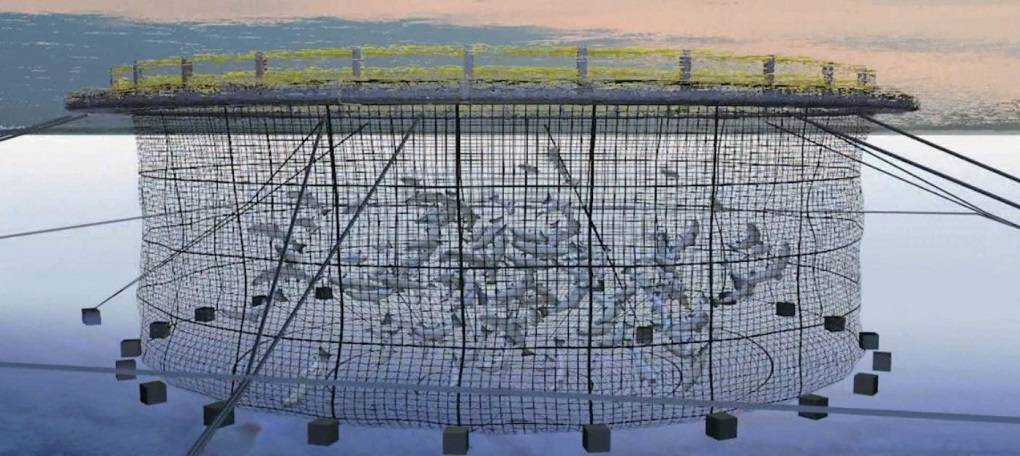
It is believed that cage culture was developed in Southeast Asia by the end of the 18th Century. Cages made from either bamboo or wood were used to confine fish. Slowly the culture evolved and fishermen started using cages to not only accumulate fish for the market but also use it to increase their size and improve their health.
Modern-day cage culture refers to the practice of using existing water resources and confining the fish inside a type of mesh enclosure that allows for the free movement of fresh water. Free movement of fresh water removes waste and maintains good water quality. And the mesh enclosure allows the fish farmer to harvest the fish, feed them, and even observe them.
Benefits of Cage Fish Culture
-
Harvesting fish for commercial purposes is easier- In Cage fish culture, it is easier to harvest fish for commercial as well as personal use. The fish farmer can harvest the fish simply by moving them into shallow water and crowding them into a restricted area. They can also partially lift the cage outside of the water in order to harvest fish.
-
Cage fish culture does not hinder other water activities- Cages for fishes are usually set in an existing water resource. However, it does not hinder other uses of the water. For instance, people can still swim in the water, use it for irrigation, and can take a boat in it.
-
Low initial investment- A fish farmer can set up a cage culture inside an existing source of water. Not only are cages not expensive to construct, someone with little experience can construct them with ease.
Disadvantages of Cage Fish Culture
-
Fishes cannot feed themselves- Inside cage culture, fishes cannot acquire their food naturally and must be fed regularly by the farmer. It is important that their feed has all of the necessary nutrients, vitamins, and minerals for their proper growth.
-
Limited production- It has been noted that fewer pounds of fish per acre are produced in cages than in open pond cultures. Limited production is caused because of poor water quality, fish density, and increased incidence of disease.
-
Poaching- Cage cultures are easy targets for poachers and vandals. Therefore, to reduce the risk of poaching and vandalism, the farmer must set up their cage in a place where access to the cage is limited.
Site Selection and Water Quality
When choosing a site that is conducive to the growth and health of a particular species of fish, the farmer needs to take the proper things into consideration-
-
Temperature
-
pH levels
-
salinity
-
algal bloom
-
Access by livestock, along with access to livestock shelters
-
The size, height, and width of the existing water body
-
The direction of the prevailing wind
-
And water fluctuation during different seasons
Suitable Species for Cage Culture
The selection of species suitable for cage culture depends on disease resistance, rapid growth, the ability to efficiently consume food, along with the availability of high-quality seeds. In India, suitable species for cage culture are striped bass, tilapia, catfish, red drum, bluegill sunfish, and carp.
Construction, Placement, and Aeration of Cage
The cage is constructed with feeding rings, a frame, flotation, and mesh or netting. It is important to use materials that are durable, strong, and non-toxic. Since the fishes need to be fed on a daily basis, it is important to place the cage in a place that is easy to access and manage in any weather condition.
It is equally important to place the cage in a place with good water circulation. Studies have shown that proper aeration reduces stress amongst the fishes which improve their feed conversion efficiency and increases their growth and production rates. Aeration for cages is provided by mechanical aerators such as paddlewheels, vertical pumps, and propeller aspirators.
Food Management
The most important components of a fish’s diet include vitamins, minerals, fat, carbohydrates, and protein. Commonly, fish farmers feed their fish dry pellets, moist pellets, and fresh or frozen trash fish. How often and how much the fishes need to be fed is based on their body weight, fish size, and water temperature.
Cage Management
A poorly built cage can cause many setbacks to the production and harvesting of fish. Therefore, it is vital that the fish farmer inspect the cages regularly to make necessary repairs and ensure that the net or mesh allows for good water exchange which washes away faeces and uneaten food.
Fish Health Management
Monitoring things like feeding patterns, swimming patterns, breathing problems, skin discolouration, coming to the surface for gulping air, and reduced feeding helps to ensure that your fishes are healthy and growing properly.
Conclusion
Cage culture is a popular form of harvesting and producing fish because it is the most efficient and easiest way to raise fish. They are low on investment as they can be constructed in any type, shape, and size of the water body. However, it still requires a certain degree of expertise in constructing the right type of cage and the steps needed to be taken to ensure the well-being of the fish.











